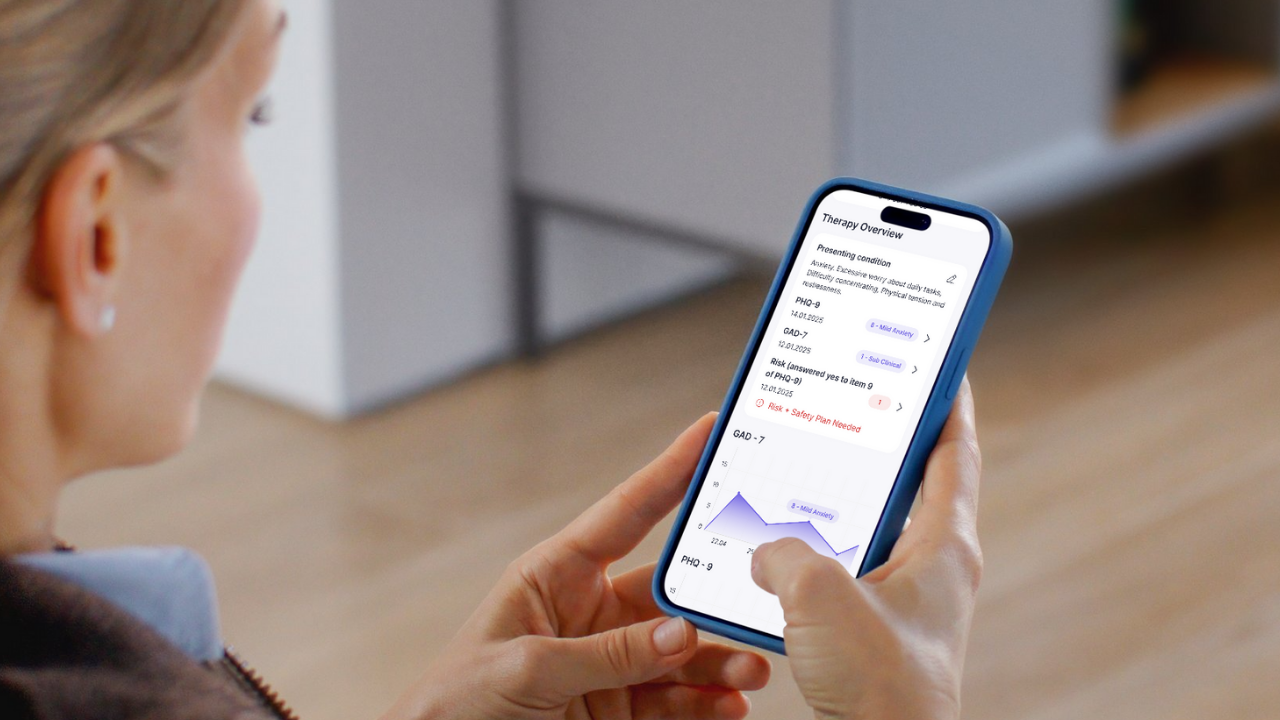AI in therapy refers to software tools that assist with administrative tasks and client engagement, rather than robots replacing therapists. It’s technology that saves you time on paperwork and helps clients stay engaged between sessions, while you keep full control of clinical decisions.
It’s about using software to handle time-consuming admin tasks and helps clients stay engaged between sessions. These tools save therapists hours on documentation, boost homework completion, and track progress, all whilst keeping you in control. Think of AI as your clinical assistant, not your replacement.
Breaking Down the Basics
At its core, this means computer software that can learn patterns, process language, and automate routine tasks. These tools analyse data, recognise trends, and assist with decision-making, but always under the supervision of a therapist.
Table of Contents
The technology behind AI therapy tools includes natural language processing (NLP) and machine learning. NLP helps computers understand and summarise spoken or written words, like session conversations. Machine learning enables these systems to continually improve over time by learning from patterns in the data. For example, an AI note assistant might learn your preferred phrasing and adapt its suggestions accordingly.
It’s crucial to distinguish reality from science fiction. AI in therapy isn’t about sentient robots conducting sessions or making diagnoses. Instead, it’s practical software that handles time-consuming tasks. Think of it as a highly capable assistant, not a replacement therapist.
The use of AI in mental health settings began in earnest around 2015-2020. Early applications focused on chatbots for basic support and screening tools. Today’s AI tools are more sophisticated, handling complex tasks like session documentation and personalised homework delivery. The NHS and major health systems now regularly test AI tools to improve efficiency and outcomes 1.
Where AI Makes a Real Difference
AI matters because it tackles the exact problems keeping you up at night. You’re losing hours each week to session notes, watching homework completion rates hover around 30%, and juggling disconnected tools that don’t talk to each other. AI addresses these specific pain points directly.
The shift to digital health isn’t slowing down. Clients expect the same convenience from therapy that they get from other services: easy scheduling, mobile access, and timely responses. AI helps you meet these expectations without compromising your clinical standards or working evenings.
Most importantly, you stay in control. AI doesn’t make clinical decisions or replace your expertise. It handles the repetitive tasks that drain your energy, giving you more time for what you trained to do: helping clients change their lives.
This isn’t about jumping on a tech trend. It’s about using practical tools that respect your professional judgement whilst freeing you from administrative burden. 1
The Building Blocks of AI Support
AI Note Assistants
Software that listens to sessions and creates draft notes in formats like SOAP. These tools learn your writing style but always need your review and sign-off.
Homework Automation
Systems that send CBT worksheets directly to clients’ phones or email. They track who’s completed tasks and send friendly nudges at the right times.
Progress Tracking
Tools that spot patterns in mood scores and outcome measures. They alert you to important changes and create clear charts for supervision meetings.
Personalised Task Matching
AI that suggests the right exercises based on what’s worked before. It adjusts difficulty when clients struggle and offers alternatives to keep them engaged.
What This Looks Like in Practice
AI tools offer practical advantages that directly address the daily challenges CBT therapists face. Here’s what the evidence shows:
Save 20-50% of documentation time per week
AI note assistants can draft session notes in minutes, not hours. You review and approve, maintaining clinical control whilst reclaiming valuable time 1.
Increase homework completion rates by up to 40%
Digital nudges and personalised reminders help clients stay engaged between sessions. AI tracks completion automatically, removing the need for manual follow-up 2.
Reduce cognitive load from switching between clinical and admin tasks
When routine tasks are automated, you can stay focused on therapy rather than paperwork. This reduces mental fatigue and helps prevent burnout 3.
Improve compliance documentation for insurance and supervision
AI tools create consistent, thorough records that meet regulatory standards. Progress tracking and outcome data are organised automatically for easy reporting 4.
Enable more consistent between-session support
Clients receive timely prompts and resources when they need them most. This continuous engagement strengthens the therapeutic alliance and supports skill practice in daily life 5.
Case Examples
Example 1 – Private Practice in London
A CBT therapist running a solo practice started using AI note-taking software last year. She now completes session notes in under 10 minutes instead of 30. That’s 5 hours saved weekly, which she uses for supervision and self-care. Her notes are more consistent too, making insurance claims smoother.
Example 2 – NHS IAPT Service
An IAPT service in Manchester integrated AI homework reminders into their CBT programme. Clients receive personalised nudges to complete thought records and behavioural experiments. Homework completion jumped from 45% to 70% within three months. The service saw better recovery rates at discharge and fewer dropouts mid-treatment.
Example 3 – University Counselling Centre
A university counselling service uses AI progress tracking to monitor student wellbeing between sessions. The system flags concerning patterns in mood logs or missed appointments. This helped identify at-risk students three weeks earlier on average. Therapists can now offer timely support before crisis points, reducing emergency interventions by 30%.
Common Misconceptions
Myth 1: “AI will replace therapists”
Reality: AI handles routine tasks like notes and reminders, freeing therapists to focus on clinical work. The therapeutic relationship and clinical judgement remain irreplaceable. AI supports your expertise, it doesn’t compete with it.
Myth 2: “AI can’t be trusted with sensitive data”
Reality: Reputable AI tools meet strict GDPR and HIPAA standards. They use encryption, secure servers, and regular audits. Many offer more robust security than paper files or basic software.
Myth 3: “It’s only for tech-savvy or large clinics”
Reality: Today’s AI tools are built for busy therapists, not IT experts. Simple interfaces mean you can start using them within minutes. Solo practitioners often see the biggest time savings.
Not All Tech Is Created Equal
- AI vs Automation: AI learns from patterns and adapts over time. Automation simply follows pre-set rules. Both save you time, but AI offers personalisation based on client data.
- AI vs Chatbots: Not all chatbots use AI, many follow basic scripts. AI therapy tools aren’t meant for client conversations. They work behind the scenes on admin and engagement.
- AI vs Digital Worksheets: Static PDFs can’t track progress or adapt to clients. AI tools respond to how clients engage, suggesting changes when something isn’t working.
Starting Small, Staying in Control
Start with one tool (notes or homework) not everything at once. Many therapists find success by testing AI note assistants first. This lets you see time savings without changing client-facing processes.
Choose platforms with therapist override controls. You should always have final say over what gets saved or sent. Look for tools that show suggestions clearly and let you edit freely.
Test with willing clients first, gather feedback. Pick clients who are comfortable with technology and open to trying new approaches. Their input helps you refine how you use AI tools.
Check compliance certifications before committing. Look for GDPR certification for UK practices or HIPAA compliance for US-based therapists. Ask vendors about data storage locations and encryption methods.
Join therapist communities using similar tools. Online forums and professional groups share practical tips and troubleshooting advice. Learning from peers speeds up your confidence with new technology.
Frequently Asked Questions
What does AI mean in therapy?
AI in therapy refers to software tools that help with administrative tasks like note-taking and client engagement. These tools support therapists by saving time on paperwork and improving homework completion rates. They don’t replace clinical judgement or the therapeutic relationship.
Is AI safe for therapy?
Yes, when properly implemented. Look for tools with GDPR and HIPAA compliance, encrypted data storage, and clear privacy policies. The best AI tools give therapists full control over outputs and require explicit client consent before use.
Can I still write my own notes?
Absolutely. AI note assistants suggest content based on session recordings or inputs, but you always review, edit, and approve final notes. Think of it as a first draft that captures details whilst you focus on your client.
What tools are UK GDPR compliant?
Check for explicit GDPR certification, UK-based data storage, and transparent data processing agreements. Reputable tools will display compliance badges and provide detailed privacy documentation. Always verify before sharing any client information.
Do clients need to opt in?
Yes, informed consent is essential. Clients must understand how AI tools will be used, what data is collected, and their right to opt out. Best practice includes written consent forms and regular check-ins about their comfort level.
A Final Thought for Therapists
AI in therapy isn’t about replacing your clinical skills. It’s about giving you back time to use them. The right tools handle the repetitive bits: notes, reminders, tracking, so you can focus on what matters: your clients.
References
- The rise of artificial intelligence for cognitive behavioral therapy – https://pmc.ncbi.nlm.nih.gov/articles/PMC12021536/[↑][↑][↑]
- Machine Learning Model to Predict Assignment of Therapy Homework in Behavioral Treatments – https://pmc.ncbi.nlm.nih.gov/articles/PMC10227700/[↑]
- Effects of an Artificial Intelligence Platform for Behavioral Interventions on Depression and Anxiety Symptoms – https://pmc.ncbi.nlm.nih.gov/articles/PMC10366966/[↑]
- The use of artificial intelligence in psychotherapy – https://pmc.ncbi.nlm.nih.gov/articles/PMC11871827/[↑]
- Generative AI–Enabled Therapy Support Tool for Improved Clinical Outcomes and Patient Engagement in Group Therapy – https://www.jmir.org/2025/1/e60435[↑]






